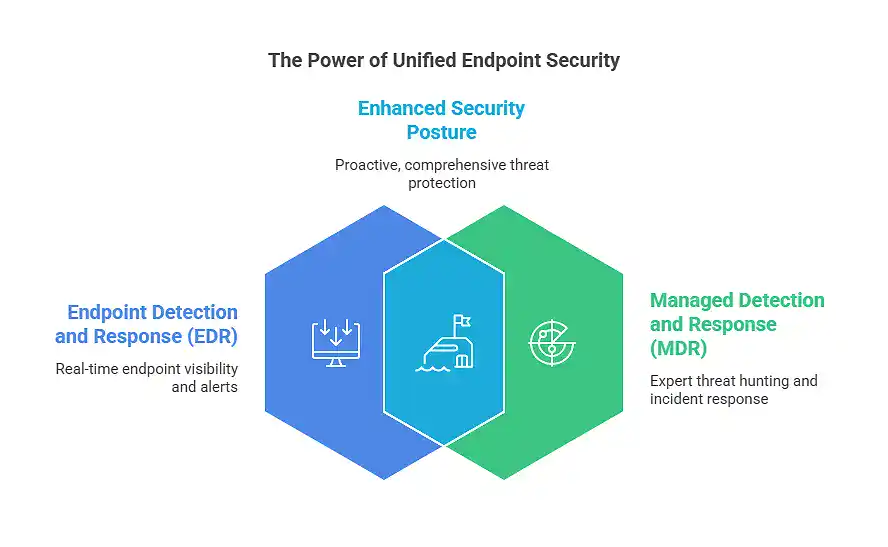MDR vs EDR: Why Detection Alone Is No Longer Enough
Nov 09, 2025

Cyber threats are advancing at breakneck speed. Today’s businesses face hundreds of alerts daily, a maze of security tools, and sprawling attack surfaces that challenge even seasoned IT teams.
According to the Mastercard Report, 43% of cyberattacks target small businesses, and the average time to identify and contain a breach is 241 days.
That’s not just a visibility problem; it’s a response problem. As Danny Tehrani, CEO at Computers Made Easy, says:
“In cybersecurity, speed and insight outweigh sheer coverage. You can’t protect what you don’t see or act on fast enough.”
This is where the debate between MDR (Managed Detection and Response) and EDR (Endpoint Detection and Response) becomes critical. It’s not just about spotting threats; it’s about neutralizing them before they cause damage.
This guide examines how MDR vs EDR differ, the scenarios each handles best, and how using both creates layered protection. Spotting danger is just the opening move; response is everything.
Don’t Let Threats Outpace You!
Protect every endpoint and network corner with proactive, expert-driven MDR and EDR solutions.
Learn MoreWhat Is EDR and Why Have Businesses Started There?
Endpoint Detection and Response (EDR) focuses on the devices you already own: laptops, desktops, servers, and mobile phones. Its core purpose is visibility: tracking activity, flagging anomalies, and automating basic responses when something looks suspicious.
The strengths of EDR are clear:
- Visibility across your network’s endpoints helps you monitor behavior in real time
- The speed of alerts allows your team to respond quickly to potential threats
- Automation enables basic remediation, like isolating infected devices before they spread
However, EDR has its limits:
- It requires internal expertise. If your team can’t analyze alerts fast enough, threats may escalate unnoticed
- It focuses only on endpoints, leaving networks, cloud services, and third-party integrations as potential blind spots
When comparing EDR vs MDR, EDR is a solid starting point, especially for companies with strong in-house security teams. But it’s not a substitute for 24/7 managed expertise. The real question is: can your team act fast enough before a threat spreads beyond the endpoint?
What MDR Brings to the Fight
Managed Detection and Response (MDR) goes beyond visibility. While EDR hands you the data, MDR acts on it. It combines automated tools with human expertise to monitor endpoints, networks, and cloud environments around the clock.
Why MDR matters to modern businesses:
- Managed service means security experts oversee your environment 24/7
- Proactive threat hunting allows analysts to spot risks before they escalate
- Faster response ensures immediate containment and remediation, without waiting for internal staff
The Managed Detection and Response market worldwide was worth USD 4.1 billion in 2024 and expected to reach $11.8 billion by 2029. MDR is gaining traction among SMBs and enterprises because it closes the gap between alert-heavy tools and real threat mitigation. It’s a step beyond EDR, offering not just visibility but actionable protection when it counts.
MDR vs EDR: Which One Handles Real Threats Better?
When real attacks hit, speed and depth of response are everything. Here’s how MDR and EDR stack up:
| Feature | EDR | MDR |
| Detection Scope | Endpoints only | Endpoints + network + cloud |
| Response | Automated alerts & containment | Automated + human-led remediation |
| Expertise | In-house required | Provided by MDR analysts |
| Monitoring | Depends on the internal team | 24/7 coverage |
| Cost | Lower upfront, internal staffing | Subscription-based, predictable |
| Threat Hunting | Limited | Continuous, proactive |
The real win isn’t just in detecting threats, it’s in neutralizing them fast. MDR vs EDR highlights a critical truth: automation alone isn’t enough. Expert monitoring and immediate action often make the difference between a minor incident and a full-scale breach.
Where EDR Still Wins
EDR shines in environments where control and customization are paramount. It’s especially effective for:
- Companies with strong in-house security teams
- Settings where granular control over every endpoint is critical
- Compliance-heavy sectors like HIPAA, PCI-DSS, and GDPR
EDR integrates seamlessly with SOAR and SIEM platforms, giving analysts deep visibility and the ability to tailor detection rules based on your business infrastructure. For regulated industries and large IT departments, the EDR vs MDR debate isn’t about missing features; it’s about maintaining control and building precision into your defenses.
Where MDR Takes Over
MDR becomes essential when internal resources are limited or stretched thin. It’s the go-to solution for:
- Businesses without a full-time security team
- Organizations that need 24/7 monitoring without hiring specialists
- Complex or distributed networks requiring fast, expert remediation
MDR also delivers cost efficiency. Staffing multiple analysts across shifts is expensive. An MDR subscription offers you both technology and human expertise in one streamlined package.
EDR vs MDR: How They Can Work Together

The smartest security strategies don’t choose between EDR and MDR. Instead, they combine them.
- EDR provides endpoint visibility, collects data, and triggers alerts
- MDR acts on that data, hunting threats, investigating incidents, and responding in real time
This hybrid approach lets you retain analytical control while outsourcing the heavy lifting to experts. Companies that use both see faster containment, broader threat visibility, and reduced pressure on internal teams.
Today, adopting both EDR and MDR is stronger than using either one alone. Detection is just a single step. The real deal is a strategy that adapts, responds, and protects at scale.
How to Choose Between MDR and EDR for Your Business
The right choice depends on your organization’s size, resources, and risk profile.
Here’s how to think it through:
- Company size: Smaller teams often benefit more from MDR’s fully managed approach. Larger enterprises with dedicated security teams can leverage EDR’s flexibility and control.
- Internal expertise: If you have skilled analysts who can interpret alerts and act quickly, EDR may be enough.
- Compliance needs: Regulated industries may require the granular control and auditability that EDR provides.
- Budget: MDR offers predictable, subscription-based pricing, often more cost-effective than building a 24/7 in-house team.
Quick Guide:
- Need control → Choose EDR
- Need constant protection → Go with MDR
- Need speed + insight → Blend both solutions
The Future of Threat Response: MDR vs EDR in the AI Era
Artificial intelligence is reshaping how businesses detect, analyze, and neutralize threats. AI-powered security solutions help companies identify threats 60% quicker than conventional methods.
Both EDR and MDR platforms now use AI-driven analytics to spot anomalies faster and reduce alert fatigue. However, while machines excel at pattern recognition, human intelligence remains essential for interpreting context and making high-stakes decisions.
The future isn’t about choosing between MDR and EDR; it’s about combining them.
When businesses integrate tools, expert oversight, and AI-powered insights, they can build a proactive, multi-layered defense. This hybrid model improves threat visibility and response speed. It also prepares organizations to adapt as cyber threats grow more sophisticated.
In the AI era, the smartest move isn’t picking sides. It’s building a security strategy that’s flexible, intelligent, and ready for what’s next.
MDR vs EDR Capabilities Breakdown
A deeper comparison of how MDR and EDR stack up across critical security functions:
| Capability | EDR | MDR | Notes |
| Threat Intelligence | Basic feeds | Advanced & contextual | MDR provides actionable insights, not just raw data |
| Incident Escalation | Manual | Automated + analyst-led | MDR enables faster, expert-driven resolution |
| Cloud Integration | Limited | Full multi-cloud | MDR supports hybrid and remote environments |
| Endpoint Forensics | Basic logs | Full forensic investigation | MDR uncovers root causes, not just symptoms |
| Compliance Support | Endpoint-level | Multi-layer & audit-ready | MDR helps meet frameworks like SOC 2 and ISO 27001 |
This breakdown highlights the practical value MDR adds, especially for businesses with complex, distributed, or regulated environments.
Partner with Computers Made Easy to Secure Your Business with MDR and EDR
Choosing between MDR and EDR doesn’t have to be confusing. EDR delivers endpoint visibility and analytical depth. MDR provides 24/7 expert-led protection and rapid response. Together, they form a hybrid defense that covers every layer of your IT environment.
Computers Made Easy has 27+ years of experience and supports 307+ companies across the US. With certified Tier-3 technicians and structured SLAs, your business gains both insight and action.
Contact us today to evaluate your IT security strategy and schedule a consultation.




